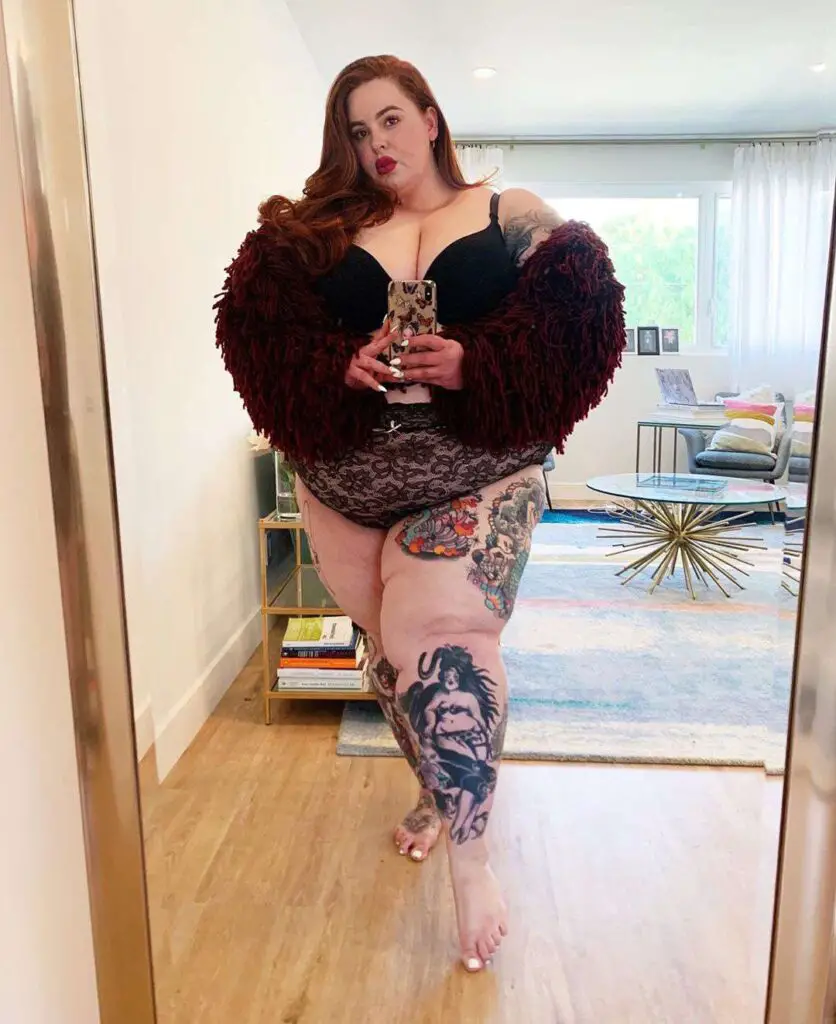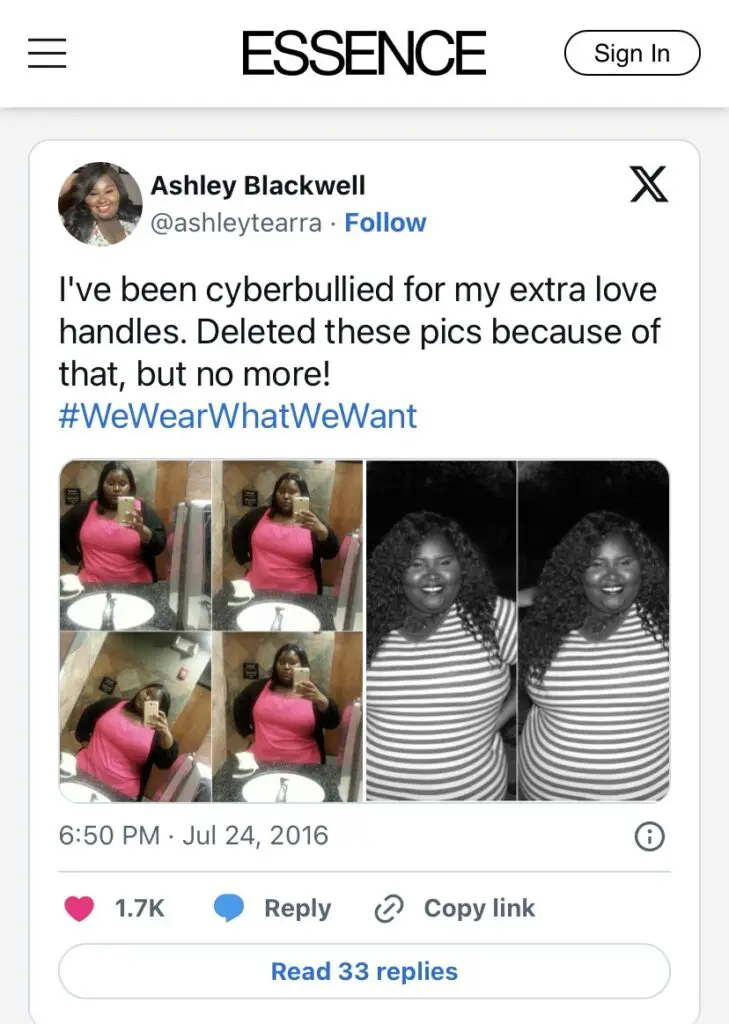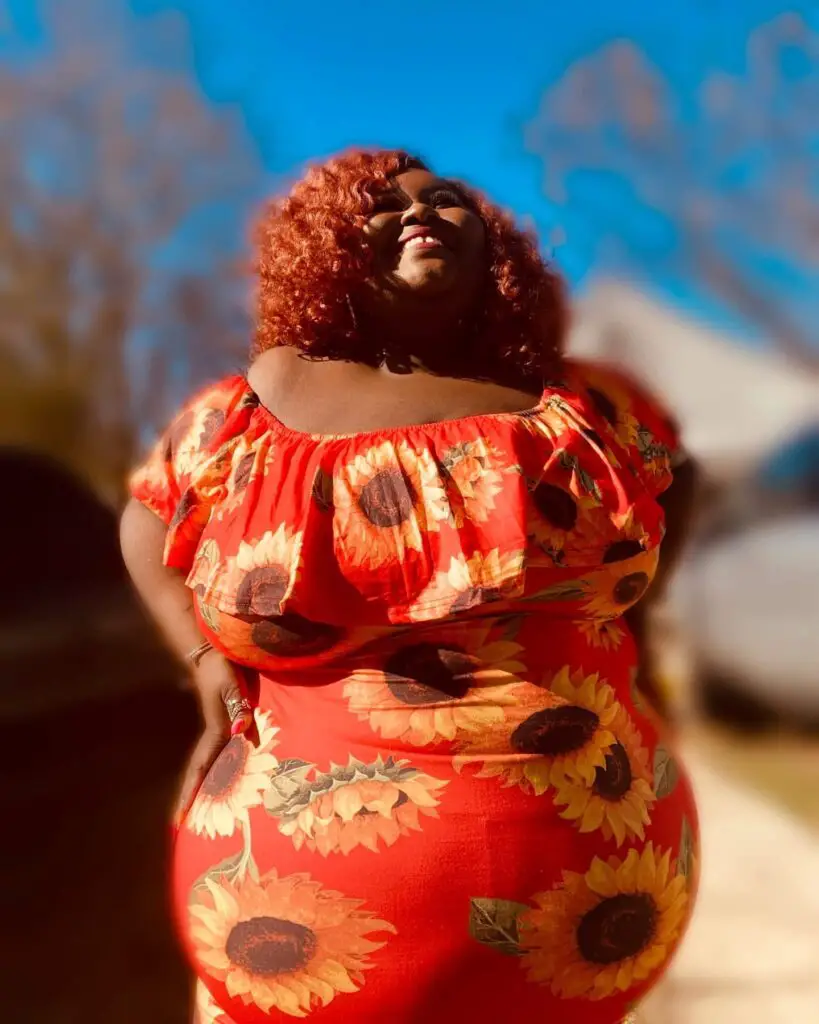“Fat is wrong, and you don’t belong.“
Before I learned of the body positivity movement, those were the words grade-school me often told myself as echoes of cafeteria cackles and nitpicking from the neighborhood kids taunted me from my mind to the mirror. The one I’d sheepishly sit in front of before the dreadful ride to the drop-off line at Randolph Park Elementary in the mornings. For the life of me, I couldn’t understand why my mere presence prompted looks of disgust from classmates, who’d scoot their lunch trays away from mine as the triggering term “ew” left their adolescent lips at the slightest accidental shoulder bump.
When they weren’t sniggering, there were the more silent attempts to single me out, such as finger-pointing paired with antagonizing feet kicking against my chair and a “so what” smirk when I’d meet them with my ferocious glare. They acted as if my fatness were contagious. Vile. Illegal even. I was the sensitive, soft-spoken, big, *DARK-SKINNED* girl who was too shy and afraid to stand up for herself, though, and they knew it. Instead, tears would well up in my eyes, as I wondered what I could’ve done so badly to deserve that type of treatment… just by simply existing.
I spent a lot of my early years hiding my truest self because of that, dimming my bright light, overcompensating with my trauma-responding humor, and overplaying my part just to be seen and heard outside of the loving household I’d been brought up in. I come from a Southern family–raised on cornbread, collard greens, and heart-warming hugs–with many of the elders flaunting a homegrown build and “potato-salad arms” (if you get my drift). So, thankfully, I can’t relate to the stories about a miserable Grandma Gretchen or Auntie Anne fat-shaming at holiday gatherings, scolding one for how “huge they’ve gotten” and plate-watching on the sidelines.
My mother never stopped reminding me how beautiful I was, and her confidence as a fellow plus size woman was inspiring to witness, too. However, although she’d kiss my chubby, little chocolate cheeks and brag about how precious her baby girl was, her high self-esteem didn’t rub off on me. The truth was… she could tell me those things a million and one times, but it wouldn’t mean a thing if I didn’t feel pretty. And I didn’t. It wasn’t until the world made my obesity a social abomination that I realized it was a problem… to them, at least. I wanted to fit in without the ridicule of taking up space or being too much for the in-crowd.
By the mid-to-late 2000s, my mother had taken me out of the public education system (in my fourth-grade year) and decided to homeschool my older sister and me. Between the bad environment and the bullying, she was left with no choice. Schooling from home gave me nothing but time to discover the then-blossoming gem of the internet: social media. From there, things changed. I created my own safe spaces through long-distance friendships formed over common interests. People liked me online. They made me feel good about myself. They offered me the opportunity to be the boisterous, outgoing, infectious soul I was too fearful to be in real life.
Suddenly, the popularity I’d longed for as a child became my virtual escape throughout my pre-teen and teenage years, which were riddled with fan-girl forums for my favorite boy bands. My weight didn’t matter in these digital communities, as the individuals within them didn’t know me beyond my username or a tiny avatar of a doctored-up image of myself, from the neck up.
Then… one day, while browsing through the cyber streets, I stumbled across the now-controversial #bodypositivity movement. This is when the shift happened.
How I Discovered the Body Positivity Movement & The History Behind It
My introduction to body positivity occurred in the 2010s, as I sat between the walls of my all-pink bedroom, scrolling through what was then called Twitter (now X) and Instagram. What was once viewed as an armor of shame was a statement of empowerment. To be fat… to be free… to be all of the things I’d forever been told I couldn’t be, something about that felt invigorating. I no longer had to conceal my authentic self behind filters and face-only photos. There were girls and women who looked like me and owned their bodies and everything that came with them.
While I’m unsure of the (exact) year, the era of 2013/2014 sticks out to me. I remember the curiosity it ignited in me, gushing at the unapologetic liberation that numerous full-figured ladies displayed, which had never been represented in such a way before. Granted, fluffy queens like actress/comedienne Mo’Nique and model Toccara Jones spearheaded The Curvy Committee during Y2K, specifically in the entertainment arena, but what was different about this trend was the fact that these were everyday people—dominating an untapped territory… with nothing but a hashtag and realistic physiques to show for it. Regardless of what others’ opinions were on their appearance. Because of this, these babes felt even more relatable to the average fat person who didn’t have the funds to purchase fancy clothing to make their statures conventionally appealing, attractive, or accepted.
But, first, before we delve deeper: what is body positivity, and where did it come from?
According to Verywell Mind, body positivity is a framework that “refers to the assertion that all people deserve a positive body image, regardless of how society and popular culture view ideal shape, size, and appearance.” Another interpretation from Psychology Today described it as an infrastructure “to accept bodies of all sizes and types, rather than those that conform to societal ideals of beauty.”
However, while new-age constructs strive for the body positivity movement to be more inclusive, its origin derives from fat activism. Reportedly, following the Victorian dress reform (a crusade against the wearing of restrictive vintage garments for women in the 1800s), late radio personality Steve Post is said to have historically jump-started the coalition when he gathered dozens for a monumental “Fat-in” event in New York City’s Central Park. The game-changer, which took place in 1967, garnered a write-up in The New York Times, titled “Curves Have Their Day in Park; 500 at a Fat-in Call for Obesity.”
In the article, published on June 5 of that year, the outlet wrote, “Short fat people, tall fat people and dozens of slim people who said they wished they were fat, gathered in Central Park yesterday afternoon to celebrate human obesity.”
The Times furthered, “They carried banners (“Fat Power,” “Think Fat,” “Buddha Was Fat”), wore buttons (“Help Cure Emaciation, Take A Fat Girl to Dinner”), and performed antislim rituals (they ceremoniously burned diet books, a large photograph of Twiggy the teenaged ectomorph, who is one of the world’s leading mannequins, and stabbed a cold, fat watermelon.)”
At the time, a recently overweight Post was a 23-year-old chief announcer for WBAI-FM and organized “Fat-in” due to discrimination against those on the larger end of the scale. He told the publication, “The advertising campaigns have attempted to make us feel guilty about our size.”
Post added, “People should be proud of being fat. We want to show we feel happy, not guilty. That’s why we’re here.”
His fight for fat equality motivated writer Lew Louderback to pen “More People Should Be Fat,” a personal essay for the Saturday Evening Post, retaliating against the shunning of plus size people. Louderback’s piece led to engineer Bill Fabrey founding the National Association to Advance Fat Acceptance in 1969. Per their website, the NAAFA (once known as the National Association to Aid Fat Americans) is “a non-profit fat rights organization dedicated to protecting the rights and improving the quality of life for fat people.”
By the 1970s, California feminists who, too, were angered by the unfairness toward the plump party started the Fat Underground. According to a 1998 piece by Radiance Magazine Online, the group “asserted that American culture fears fat because it fears powerful women, particularly their sensuality and their sexuality.” Moreover, they “employed slashing rhetoric: Doctors are the enemy. Weight loss is genocide. Friends in the mainstream-sympathetic academics and others in the early fat rights movement urged them to tone it down, but ultimately came to adopt much of the Fat Underground’s underlying logic as their own.”
Fast forward to the 1990s, anti-fat commercials, diet programs, and industry beauty standards overrode many of the decades-long initiatives in place to end skinny bias. This wave would spill over into the 2000s when sizes as low as 8 were considered “plus size” and women (directly) were pressured to meet the physical expectations that replicated video vixens and magazine models. But… a new dawn and day arrived in the 2010s, spawning what we know the body positivity movement to be today.
The Rise & Fall of the Movement & What Its Dynamic Impact Has Done for Me & Many Others
Growing up, I despised the way the excess fat behind my neck (medically referred to as a buffalo hump) protruded upward, making it (almost) impossible to sleep on my back comfortably or take aesthetically-pleasing pictures in strapless attire. I always felt as if I were awkwardly shaped, being that my breasts were larger than most around my age, and my stomach hung over my pants. Adding insult to injury, my legs were smaller, causing an uneven, top-heavy ratio.
In a period where healthy bottoms were a thing, as a young adult, I suffered from the effects of being poorly proportioned: feeling undesirable–to others… and myself. I’d envy those, like my big sister, who were pear-shaped (small-chested and wide-hipped), with curves too nice to be covered. Even most of the celebrity women who were poster children for the plus size didn’t resemble me, and that kept me in a constant loop of wishing I could look like the ones everyone fawned over. Let’s face it, my apple-like anatomy was not socially acceptable.
The rise of the body positivity movement on social media not only redefined cultural merits but also what my body meant to me. Yes, in all of its marked-up glory, extra layers of love, and shea-buttered rolls. It let me know that my flaws and flabs didn’t make me any less of a valid human than those who paraded their “I’m fit” flags as if my heaviness was an automatic indicator of failing health. With various brands and mainstream acts joining the advocacy, body positivity morphed into a global phenomenon right before our eyes. OG YouTubers were teaching the voluptuous baddies how to dress. Corporations were looking into size expansions. Embracing yourself wherever you were became an emphasis. What a time it was to be alive.
Then… Tess Holliday screamed to the naysayers, “EFF YOUR BEAUTY STANDARDS.” The campaign, founded in 2013, strategically reinforced the agenda to challenge society’s “pretty playbook,” foster connections among those outside of the norms, and increase diversity. Holliday, who hails from Mississippi and has served as a staple in the plus size realm, changed the narrative and single-handedly showed us all that there’s no margin in modeling or weight to one’s worth. Without a doubt, her audacious approach helped fat fashion’s progression over the last decade and heightened the visibility of big bodies in several companies’ marketing roll-outs.
Not to be confused, though, Holliday’s breakout was certainly contentious for those outside the market, who were notorious for accusing her–along with others–of pushing a “harmful,” pro-obesity message. The only questions I have to ask about that are: Since when did it become dangerous to love yourself? Are we not allowed to do so because we’re fat?

The face of some of today’s most lucrative clothing lines (Torrid, H&M, ELLE, etc.), it’s safe to say that Holliday has opened countless doors for her successors. As influencers continued to skyrocket on X (then Twitter) and Instagram, different body types were highlighted, giving women like me the courage to live a life beyond the restrictions of someone else’s unsolicited advice. With that, I never would’ve guessed that participating in a Twitter thread would grant me my own not-so-sweet taste of the body-positivity pie.
Internet personality Simone Mariposa’s 2016 hashtag #WeWearWhatWeWant called for the plush girlies to post themselves (rocking whatever they felt comfortable in) in response to the ongoing body-shaming that those of us in extended sizes have long endured. Mine, which just so happened to feature me in bright pink and all stripes, obtained hundreds of likes and replies, with even an interview offer for Today.com and sightings on Essence and Buzzfeed. While the outpouring of attention gave me a glimpse of “fifteen minutes of fame,” the hatred trampled the support… for me, and I recall contemplating removing the post as I cried to my loved ones, feeling as if I were that little girl battling for normalcy again.

As if the “promoting obesity” remarks weren’t astonishing enough, Twitter users referring to me as everything from “smelly” to “monkeys” shot multiple daggers that set me off course on the self-love journey I’d been marching through since childhood. It seemed as if it were an obstacle that I would never overcome, even if it were only for a split second in hindsight.
But I did.
Soon enough, the noise began to fade, and the jokes weren’t so loud anymore. I celebrated myself for all that I was and would become. That experience sparked my passion for speaking out on issues related to plus-size representation. Whether it was through an online status or in conversation with close friends, I never backed away from my stance: fat people matter, too. Women, especially. And I’m not holding any hands, but I will tussle when I say this… we feel the effects of fatphobia the most, and it’s unfortunate. Sometimes, even from our own. That’s a topic for another day, so I’ll leave that there.

But it’s through avenues like the body positivity movement that we’ve been able to combat the innumerable stigmas and stereotypes placed upon us and protest for clothing brands to serve more than one body type. I do believe plus size fashion has come a long way, but until companies that “cater to the curvy” can strip away the thinking that offering a 2X or 3X is inclusivity, so much more work is to be done. That’s the cold-hearted truth.
Although once a thriving sector for small-to-super fats, one would (maybe) agree that body positivity isn’t as forefronted as it once was for us, especially with the expansivity of those falling under the umbrella of its usage and the masses labeling it “toxic.” Additionally, aside from claims that it’s detrimental to American health, others have accused the community of being a catalyst for forced positivity. In a 2022 episode of The Feisty Women’s Performance Podcast, fat cyclist Marley Blonsky said, “Body positivity is just being overwhelmingly positive about our bodies, and I just don’t think that’s realistic.”
She expanded, “I get frustrated every day with something with my body, whether it’s my knee, my hair, etc… accepting the things that I don’t love about my body, like right now my knee, it’s still giving me trouble two months after surgery. I don’t have to love that, you know, I think there’s a big body positivity movement, right? And like, ‘I love my rolls. I love my cellulite.’ Like, why? Yes, it’s a part of your body that does really cool things. But it’s okay to be nuanced.”
When (seemingly) speaking on why body neutrality has been more beneficial for her, Blonsky cited: “Being neutral about your body is accepting that there are both good and bad things and being grateful for what your body does for you,” later concluding, “Body neutrality plays directly into fat activism. Me feeling positive about my body isn’t going to change the size of the airplane seat or the doctor I see for my knee trouble, and he says, ‘Well, you need to lose weight.””
In conclusion, while perspectives differ, I feel that it would be counterproductive to downplay what the body positivity movement did for growing girls like me, who lacked social spaces to bask in the beauty of their bodies. Who lacked freedom, especially as a fellow fat person, to say: “This is who I am, and I love who I am.” Although every day won’t be perfect, and no, you won’t love (or even like) every part of yourself. However, body positivity is more than shouting from the rooftops how great your big body looks in a bikini. Instead, it’s permitting yourself to live, to laugh, to cherish, even on the days when it feels impossible… because you have that right.
It’s giving a stage to marginalized people that could open confidence-building pathways for those who weren’t brave enough to stand under the spotlight and in front of the camera. Way too often, as plus size women (in particular), we’re made to feel as if grabbing onto the parts of ourselves we aren’t too focused on “changing” for the public’s eye is wrong. As if the only time we should wear a smile is when our waists are slim. But, the reality is, it’s in those moments that we love ourselves where we are instead of where we’re trying to go, that we can discover the most gorgeous cracks and crevices of who we truly are.
For some, this is done through the things that mean the most to them, the company they keep, the attributes they embody, or something as simple as the clothes they wear. With media entities like The Curvy Fashionista, our message rips through the backlash of the 21st century’s erasure of larger-size individuals’ human rights and feelings and provides a billboard for bodies that are no longer barricaded behind get-thin-quick teas or starvation formalities.
No more hiding. What you see… is what you will get.
thecurvyfashionista.com (Article Sourced Website)
#OpEd #Candid #Unraveling #Body #Positivity #Movement
